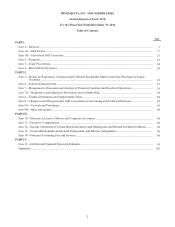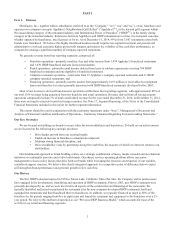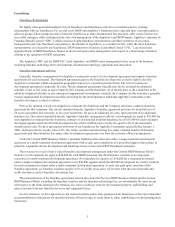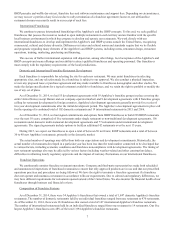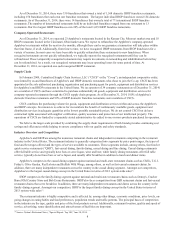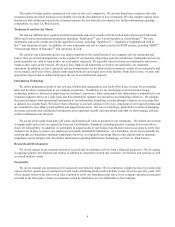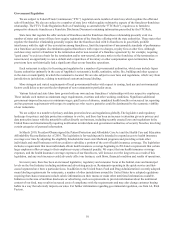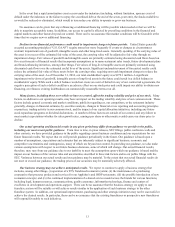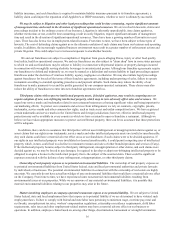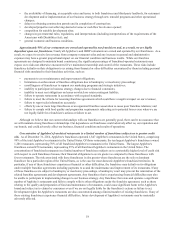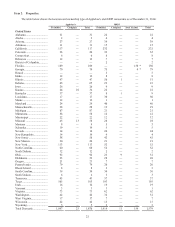IHOP 2014 Annual Report Download - page 31
Download and view the complete annual report
Please find page 31 of the 2014 IHOP annual report below. You can navigate through the pages in the report by either clicking on the pages listed below, or by using the keyword search tool below to find specific information within the annual report.12
• reduce gross sales at franchise restaurants, resulting in lower royalty and other payments from franchisees,
• reduce the profitability of franchise restaurants, potentially impacting the ability of franchisees to make royalty
payments when they are due and to develop new restaurants as may be required in their respective development
agreements, and
• negatively impact the financial performance of our company-operated restaurants.
Our level of indebtedness could adversely affect our financial health and prevent us from fulfilling our obligations
under our debt. As of December 31, 2014, certain of our indirect, wholly-owned subsidiaries had approximately $1.3 billion
of long-term debt. In addition, we had approximately $0.2 billion in financing and capital lease obligations as of December 31,
2014. Our level of indebtedness could have important consequences to our financial health. For example, it could:
• make it more difficult for us to satisfy our obligations with respect to our debt or refinance any of our debt on
attractive terms, commercially reasonable terms, or at all;
• increase our vulnerability to general adverse economic and industry conditions or a downturn in our business;
• require us to dedicate a substantial portion of our cash flow from operations to debt service, thereby reducing the
availability of our cash flow to pay dividends to our stockholders, repurchase shares of our common stock, fund
working capital, capital expenditures and other general corporate purposes;
• limit our flexibility in planning for, or reacting to, changes in our business and the industry in which we operate;
• place us at a competitive disadvantage compared to our competitors that are not as highly leveraged;
• limit, along with the financial and other restrictive covenants in our indebtedness, among other things, our ability to
borrow additional funds; and
• result in an event of default if we fail to satisfy our obligations under our debt or fail to comply with the financial and
other restrictive covenants contained in our debt documents, which event of default could result in all of our debt
becoming immediately due and payable and could permit certain of our lenders to foreclose on our assets securing
such debt.
In addition, we may incur substantial additional indebtedness in the future. If new debt is added to our current debt levels,
the related risks that we now face could intensify.
The terms of the securitized debt issued by certain of our indirect, wholly-owned subsidiaries have restrictive terms and
the failure to comply with such restrictive terms could put us in default, which would have an adverse effect on our business
and prospects. Unless and until we repay all outstanding borrowings under our securitized debt, we will remain subject to the
restrictive terms of the securitized debt issued by certain of our wholly-owned subsidiaries. For example, the indenture entered
into by such subsidiaries in connection with the securitized debt contains covenants that limit the ability of certain of our
wholly-owned subsidiaries to, among other things: sell assets; alter the business conducted by such subsidiaries; engage in
mergers or acquisitions; declare dividends or redeem or purchase certain equity interests; incur, assume or permit to exist
additional indebtedness or guarantees; make loans and investments; incur liens; and enter into transactions with affiliates other
than on an arms-length basis. These covenants are applicable only to the securitization subsidiaries and do not apply to any of
DineEquity, Inc., International House of Pancakes, LLC or Applebee’s International, Inc. as these entities are not a party to the
indenture. A breach of a covenant could result in a rapid amortization event or default under the securitized debt.
Further, the securitized debt also includes limitations on our ability to incur additional indebtedness and contains a number
of financial performance measures that must be met to avoid a possible rapid amortization event or event of default. The most
significant of these measures include a minimum debt service coverage ratio and minimum domestic franchise system sales.
The ability to meet these financial performance measures can be affected by events beyond our control and there can be no
assurance that we will satisfy these financial measures.
If amounts owed under the securitized debt are accelerated because of a default and we are unable to pay such amounts, the
investors may have the right to assume control of substantially all of the securitized assets, which consist of substantially all of
our domestic revenue-generating assets and domestic intellectual property.
During the seven-year term following issuance, the outstanding fixed-rate senior notes will accrue interest at a rate of
4.277% per year. Additionally, the fixed-rate senior notes have scheduled quarterly principal amortization payments of $3.25
million. If we maintain a leverage ratio of less than or equal to 5.25x total debt to EBITDA, we may elect to not make the
scheduled principal payments.
If we are unable to refinance or repay amounts under the securitized debt prior to the expiration of the seven-year term, our
cash flow would be directed to the repayment of the securitized debt and, other than a weekly management fee sufficient to
cover minimal selling, general and administrative expenses, would not be available for operating our business.


